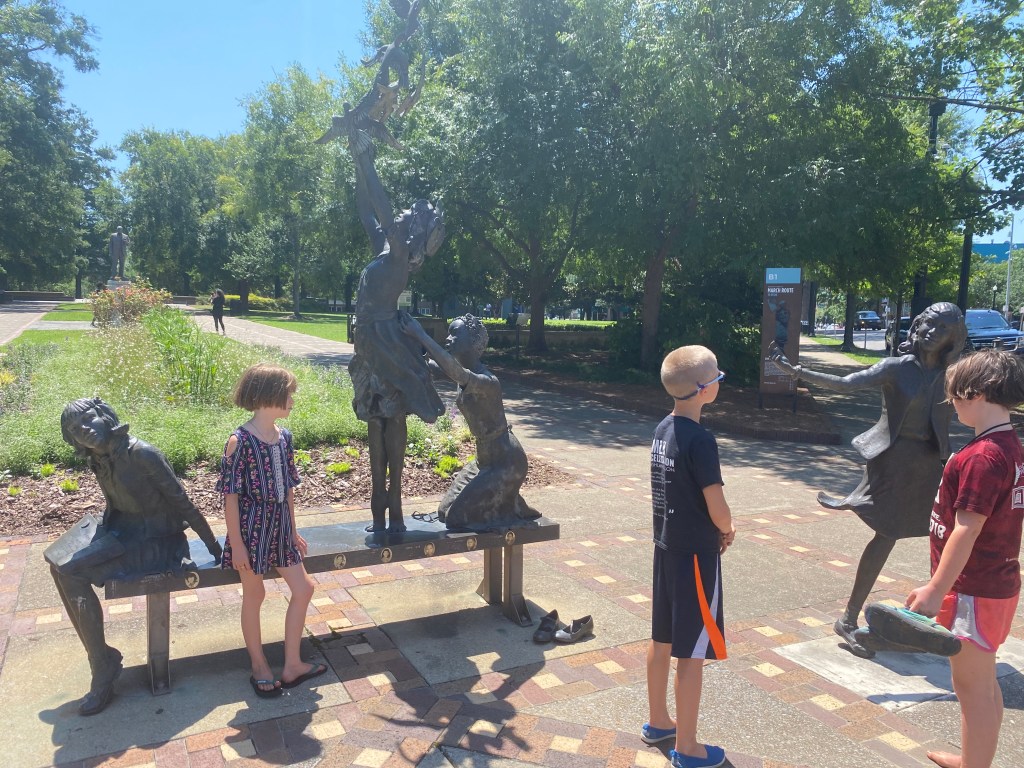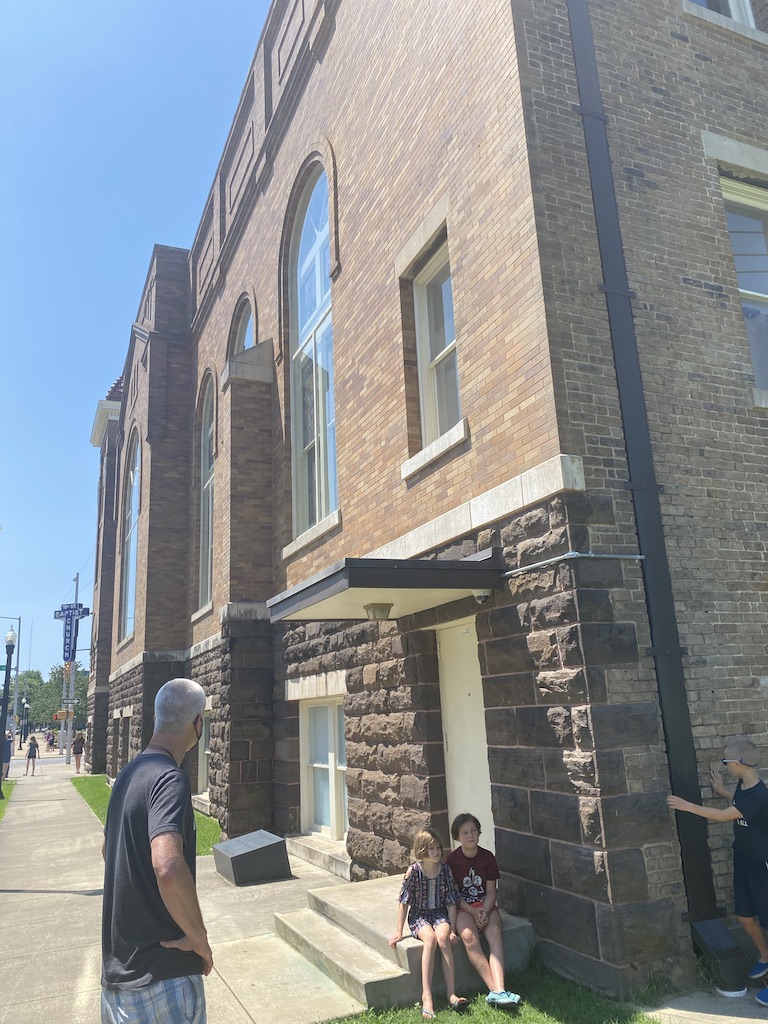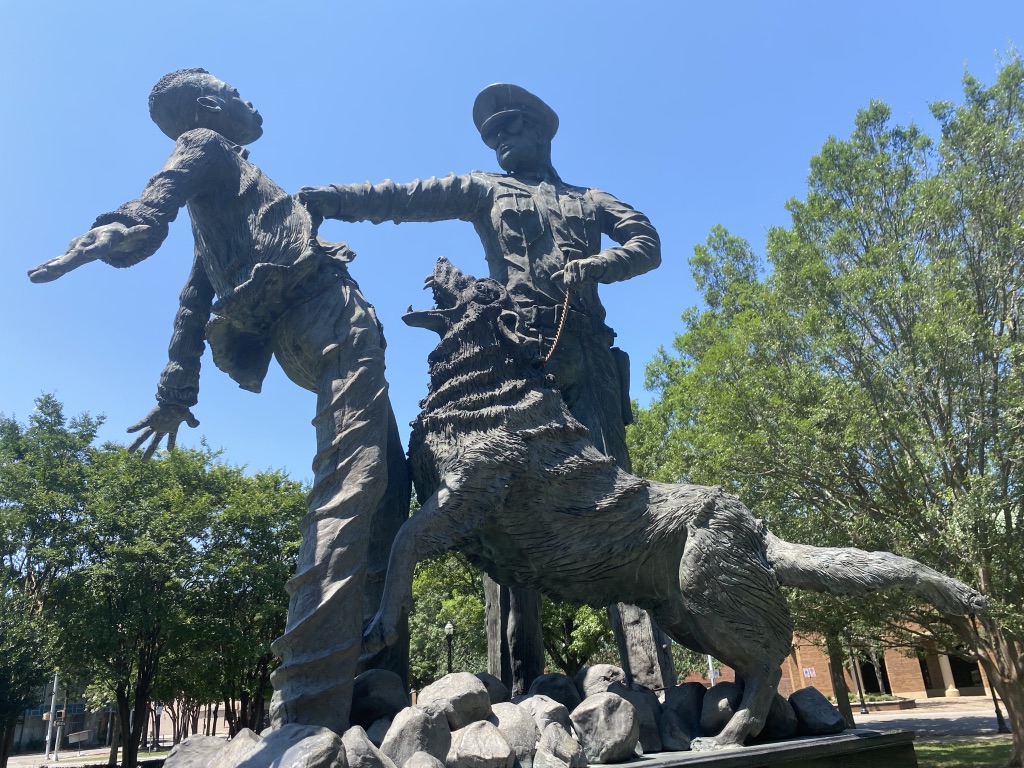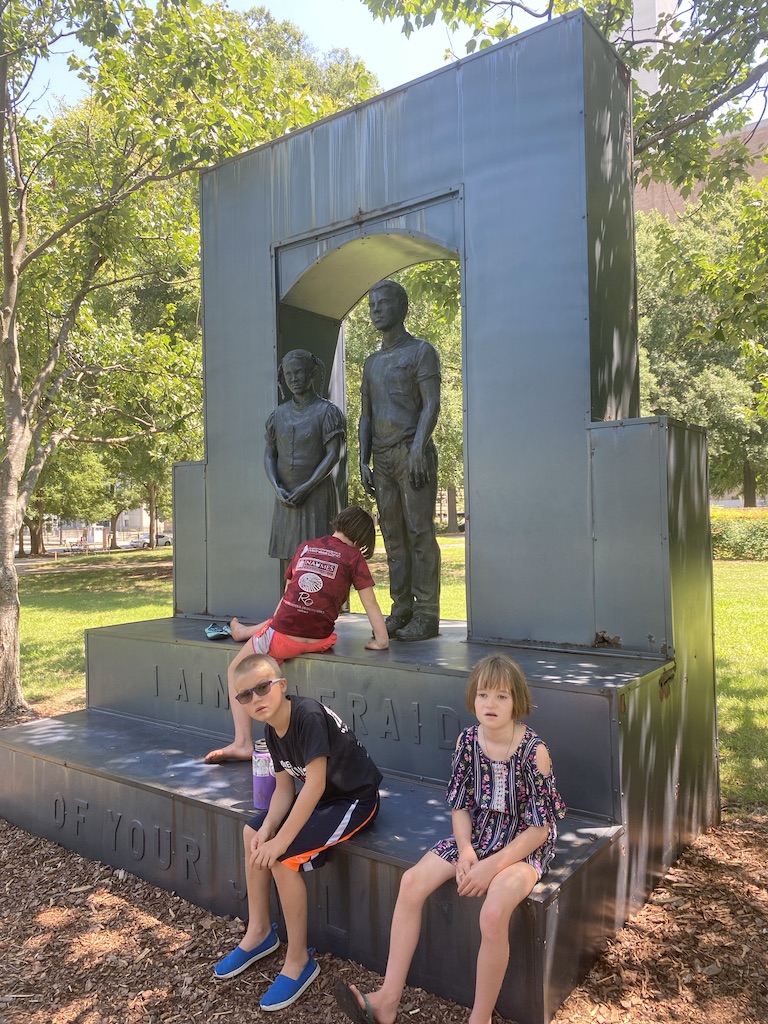
Our airbnb in Montgomery allowed us so much comfort that we decided to make Birmingham a day trip, which for our purposes was perfect. We got up early and made the hour and a half trip from Montgomery along the highway on the 4th of July. Upon arrival in Birmingham we parked our rented minivan beside the famous Kelly Ingram Park and were immediately greeted by a friendly Black man who initiated a conversation with us about the racist history of Birmingham. He had an abundance of historical information to share with us about the involvement of children in the movement and details of the bombing at 16th Street Baptist church, which killed four young school girls. The surface level conversation became more intimate when he shared with us that he had children and was in a hard way. Jay and I had gotten into the habit of opening our wallets when we would be approached by Black bodied people who asked for us for money. We felt like it was necessary to spend as much money by giving to folks in need as we were spending in admission fees to museums and gas. We ended up giving this particular person one hundred dollars. It felt like the right move in the moment and still does. Looking deeply at American history, a history that includes the kidnapping, transportation, enslavement, murder and imprisonment of multiple races of people (BIPOC people) has fundamentally changed how we respond to bodies of color who are living on the street. We make no assumptions that they are to blame for the circumstances they find themself in. In fact quite the opposite, we assume that they are houseless and hungry for reasons beyond their control and certainly not by choice or laziness.
Why was Birmingham important?
Sometimes referred to as “Bombingham,” Dr. Martin Luther King Jr. called it “the most segregated city in the country”. The Birmingham Campaign was organized in 1963 by the Southern Christian Leadership Conference (SCLC) to bring attention to efforts for integration in Birmingham by its Black residents. The nonviolent protests led by Fred Shuttlesworth, Martin Luther King Jr, and others, quickly became the focus of national media due to the extreme violence inflicted on young protestors by law enforcement officers. Images and videos of young Black activists being attacked by police dogs, pummeled by high pressure fire hoses and threatened with rifles, sparked national focus on the south and the racism that was alive and well there. 16th Street Baptist Church became a planning and training location for the demonstrators. Students from colleges, high schools and junior high schools, and elementary students came together to be trained in nonviolent activism and would then leave the church 50 at a time to walk to the mayor’s office to discuss desegregation. The authorities, under the instruction of Eugene “Bull” Connor, would not only physically assault the students, thousands of youth were arrested and jailed for participating in the protests. However, despite the danger the young activists faced, they persevered and the Birmingham movement would later be credited with being the catalyst for the Civil Rights Act of 1964, which outlaws discrimination based on race, color, religion, sex, national origin, and later sexual orientation and gender identity.
On the corner of 16th St and 6th Ave

The 16th St Baptist Church organized originally as The First Colored Baptist Church of Birmingham, it was the first Black church in Birmingham in 1873. Because of its affiliation with the civil rights movement it became the target of racist attacks by the KKK. The church was bombed by four white men who planted 19 sticks of dynamite on On Sunday, September 15, 1963 at 10:22 am killing four young school girls and injuring 22 others who were preparing for “Youth Day.” The victims of this hate crime were: Addie Mae Collins (age 14, born April 18, 1949), Carol Denise McNair (age 11, born November 17, 1951), Carole Rosamond Robertson (age 14, born April 24, 1949), and Cynthia Dionne Wesley (age 14, born April 30, 1949). A funeral was held for 3 of the 4 children and over 800 people attended, although no government or city officials were present. This bombing was one of 45 bombings that took place within a decade. The church received over $300,000 in unsolicited gifts to begin rebuilding and a gift of a stained glass window depicting Black Jesus from Wales which was installed in the front window. The church was to reopen June 7, 1964. However, when our family was there the church had been closed to the public due to Covid. The welcome sound of music came from inside the building, enticing us to stand on the front steps with our ears longingly pressed against the door.



500 17th St N, Birmingham, AL 35203

The place that was home to many important protests, speakers, conventions and conflicts, which caught the attention of a nation that had previously been blind to racism; a white-dominated society that believed it had moved past racism after abolishing slavery 100 years before. Today the park serves as a monument with multiple sculptures that evoke a visceral response. Each one depicting a different element of the era and place, such as two walls that between them have bronze attack dogs lunging at the passerby. The focus of the sculptures is mostly on the young activists and the impact of the authorities on the child protestors. There is an audio tour of the park and the art installations that can be downloaded onto your phone for interaction. The park was also a hub of activity for many Black bodied men (there were no women at the time that we were there) who were approaching tourists and sharing stories of the events at the park. It was apparent that acting as impromptu guides to visitors was a means for a small amount of income for these locals. As I recall the experience of witnessing the uncomfortable interactions between these men trying to make money and the tourists, who had come to pay homage to the holy place, had my stomach tied in knots. I cannot help but associate the journey of America from the theft of millions of Africans to this current scenario of Black men soliciting white tourists for income with civil rights history in this bloody place. The irony and the perpetuation of inequity was unmistakable.



Birmingham Civil Rights Institute
520 16th St. Birmingham, AL

Open Tuesday- Saturday, Adults $15, Seniors & Students $13, Students 3rd grade & under FREE
We were sad to have missed this museum since it was a Sunday when we visited Birmingham. The Civil Rights Institute is located directly across the street from Kelly Ingram Park and the 16th St. Baptist Church. A statue of Fred Shuttlesworth stands outside the doors of the institute paying tribute to one of the leaders of the Birmingham Campaign.
